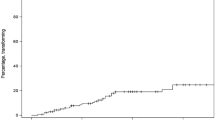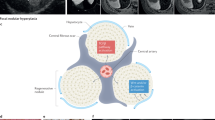Abstract
Hepatic focal nodular hyperplasia (FNH) is a nonmalignant condition rarely affecting children previously treated for cancer, especially those who received hematopoietic SCT (HSCT). Some aspects of its pathogenesis still remain unclear and a strong association with specific risk factors has not yet been identified. We report here a single institution's case series of 17 patients who underwent HSCT and were diagnosed with FNH, analyzing retrospectively their clinical features and the radiological appearance of their hepatic lesions. We aimed to compare the diagnostic accuracy of ultrasound (US) and magnetic resonance imaging (MRI) and to explore the role of transient elastography (FibroScan) to evaluate the degree of hepatic fibrosis in FNH patients. Our analysis showed an association of FNH with age at transplant ⩽12 years (hazard ratio (HR) 9.10); chronic GVHD (HR 2.99); hormone-replacement therapy (HR 4.02) and abdominal radiotherapy (HR 4.37). MRI proved to be a more accurate diagnostic tool compared with US. Nine out of 12 patients who underwent FibroScan showed hepatic fibrosis. Our study points out that FNH is an emerging complication of HSCT, which requires a lifelong surveillance to follow its course in cancer patients.
This is a preview of subscription content, access via your institution
Access options
Subscribe to this journal
Receive 12 print issues and online access
$259.00 per year
only $21.58 per issue
Buy this article
- Purchase on Springer Link
- Instant access to full article PDF
Prices may be subject to local taxes which are calculated during checkout

Similar content being viewed by others
References
Pezzullo L, Muretto P, De Rosa G, Picardi M, Lucania A, Rotoli B . Liver nodular regenerative hyperplasia after bone marrow transplant. Hematologica 2000; 85: 669–670.
De Bouyn CI, Leclere J, Raimondo G, Ducou le Pointe H, Couanet D, Valteau-Couanet D et al. Hepatic focal nodular hyperplasia in children previously treated for a solid tumor. Incidence, risk factors, and outcome. Cancer 2003; 97: 3107–3113.
Masetti R, Biagi C, Kleinschmidt K, Prete A, Baronio F, Colecchia A et al. Focal nodular hyperplasia of the liver after intensive treatment for pediatric cancer: is hematopoietic stem cell transplantation a risk factor? Eur J Pediatr 2011; 170: 807–812.
Masetti R, Colecchia A, Rondelli R, Martoni A, Vendemini F, Biagi C et al. Benign hepatic nodular lesions after treatment for childhood cancer. J Pediatr Gastroenterol Nutr 2013; 56: 151–155.
Sudour H, Mainard L, Baumann C, Clement L, Salmon A, Bordigoni P . Focal nodular hyperplasia of the liver following hematopoietic SCT. Bone Marrow Transplant 2008; 43: 127–132.
Smith EA, Salisbury S, Martin R, Twbin AJ . Incidence and etiology of new liver lesions in pediatric patients previously treated for malignancy. Am J Roentgenol 2012; 199: 186–191.
Masetti R, Zama D, Gasperini P, Morello W, Prete A, Colecchia A et al. Focal nodular hyperplasia of the liver in children after hematopoietic stem cell transplantation. Pediatr Transplant 2013; 17: 479–486.
Gobbi D, Dall’Igna P, Messina C, Cesca E, Cecchetto G . Focal nodular hyperplasia in pediatric patients with and without oncologic history. Pediatr Blood Cancer 2010; 55: 1420–1422.
Kondo F, Nagao T, Sato T, Tomizawa M, Kondo Y, Matsuzaki O et al. Etiological analysis of focal nodular hyperplasia of the liver, with emphasis on similar abnormal vasculatures to nodular regenerative hyperplasia and idiopathic portal hypertension. Pathol Res Pract 1998; 194: 487–495.
Craig JR, Peters RL, Edmondson HA, Omata M . Fibrolamellar carcinoma of the liver: a tumor of adolescents and young adults with distinctive clinico-pathologic features. Cancer 1980; 46: 372–379.
Vanzulli A, Morana G, Grazioli L, SIRM RM Addominale. Poletto, Milano, 2014.
Attal P, Vilgrain V, Brancatelli G, Paradis V, Terris B, Belghiti J et al. Telangiectatic focal nodular hyperplasia: US, CT, and MR imaging findings with histopathologic correlation in 13 cases. Radiology 2003; 228: 465–472.
Fowler KJ, Brown JJ, Narra VR . Magnetic resonance imaging of focal liver lesions: approach to imaging diagnosis. Hepatology 2011; 54: 2227–2237.
Ronot M ., Vilgrain V . Imaging of benign hepatocellular lesions: current concept and recent updates. Clin Res Hepatol Gastroenterol 2014; 38: 681–688.
Sandrin L, Fourquet B, Hasquenoph JM, Yon S, Fournier C, Mal F et al. Transient elastography: a new noninvasive method for assessment of hepatic fibrosis. Ultrasound Med Biol 2003; 29: 1705–1713.
Konate A, Reaud S, Quenemer E, Fouchard-Hubert I, Oberti F, Cales P . Liver stiffness measurement by transient elastography: predictive factors of accuracy and reproducibility. J Hepatol 2006; 44: 195.
Peto R, Pet J . Asymptotically efficient rank invariant test procedures. J R Stat Soc A 1972; 135: 185–198.
Rebouissou S, Bioulac-Sage P, Zucman-Rossi J . Molecular pathogenesis of focal nodular hyperplasia and hepatocellular adenoma. J Hepatol 2008; 48: 163–170.
Rebouissou S, Couchy G, Libbrecht L, Balbaud C, Imbeaud S, Auffray C et al. The β-catenin pathway is activated in focal nodular hyperplasia but not in cirrhotic FNH-like nodules. J Hepatol 2008; 49: 61–71.
Wanless IR, Mawdsley C, Adams R . On the pathogenesis of focal nodular hyperplasia of the liver. Hepatology 1985; 5: 1194–1200.
Anderson L, Gregg D, Margolis D, Casper J, Talano J . Focal nodular hyperplasia in pediatric hematopoietc allogeneic cell transplant: case series. Bone Marrow Transplant 2010; 45: 1357–1359.
Marabelle A, Campagna D, Déchelotte P, Chipponi J, Deméocq F, Kanold J . Focal nodular hyperplasia of the liver in patients previously treated for pediatric neolplastic diseases. J Pediatr Hematol Oncol 2008; 30: 546–549.
Balabaud C, Al-Rabih WR, Chen PJ, Evason K, Ferrel L, Hernandez-Prera JC et al. Focal nodular hyperplasia and hepatocellular adenoma around the world viewed through the scope of the immunopathological classification. Int J Hepatol 2013; 2013: 268625.
Nguyen BN, Flèjou JF, Terris B, Belghiti J, Degott C . Focal nodular hyperplasia of the liver: a comprehensive pathologic study of 305 lesions and recognition of new histologic forms. Am J Surg Pathol 1999; 23: 1441–1454.
Stoot JH, Coelen RJ, De Jong MC, Dejong CH . Malignant transformation of hepatocellular adenomas into hepatocellular carcinomas: a systematic review including more than 1600 adenoma cases. HPB 2010; 12: 509–522.
International Working Party. Terminology of nodular hepatocellular lesions. Hepatology 1995; 22: 983–993.
Wanless IR, Gryfe A . Nodular transformation of the liver in hereditary hemorragic telangectasia. Arch Pathol Lab Med 1986; 110: 331–335.
Mathieu D, Kobeiter H, Maison P . Oral contraceptive use and focal nodular hyperplasia of the liver. Gastroenterology 2000; 118: 560–564.
Giannitrapani L, Soresi M, La Spada A, Cervello M, D’Alessandro N, Montalto G . Sex hormones and risk of liver tumor. Ann NY Acad Sci 2006; 1089: 228–236.
La Vecchia C, Tavani A . Female hormones and benign liver tumours. Digest Liver Dis 2006; 38: 535–536.
Kapp N, Curtis KM . Hormonal contraceptive use among women with liver tumors: a systematic review. Contraception 2009; 80: 387–390.
Farruggia P, Alaggio R, Cardella F, Tropia S, Trizzino A, Ferrara F et al. Focal nodular hyperplasia of the liver: an unusual association with diabetes mellitus in a child and review of literature. Ital J Pediatr 2010; 36: 41.
Valentino PL, Ling SC, Ng VL, John P, Bonasoni P, Castro DA et al. The role of diagnostic imaging and liver biopsy in the diagnosis of focal nodular hyperplasia in children. Liver Int 2013; 34: 227–234.
Shamsi K, De Schepper A, Degryse H, Deckers F . Focal nodular hyperplasia of the liver: radiologic findings. Abdom Imaging 1993; 18: 32–38.
Buetow PC, Pantongrag-Brown L, Buck JL, Ros PR, Goodman ZD . Focal nodular hyperplasia of the liver: radiologic-pathologic correlation. Radiographics 1996; 16: 369–388.
Cherqui D, Rahmouni A, Charlotte F, Boulahdour H, Métreau JM, Meignan M et al. Management of focal nodular hyperplasia and hepatocellular adenoma in young women: a series of 41 patients with clinical, radiological, and pathological correlations. Hepatology 1995; 22: 1674–1681.
Quaia E . The real capabilities of contrast-enhanced ultrasound in the characterization of solid focal liver lesions. Eur Radiol 2011; 21: 457–462.
Frulio N, Laumonier H, Carteret T, Laurent C, Maire F, Balabaud C et al. Evaluation of liver tumors using acoustic radiation force impulse Elastography and correlation with histologic data. J Ultrasound Med 2013; 32: 121–130.
Eckersley-Maslin MA, Warner FJ, Grzelak CA, McCaughan GW, Shackel NA . Bone marrow stem cells and the liver: are they relevant? J Gastroenterol Hepatol 2009; 24: 1608–1616.
Flemming P, Tillmann HL, Barg-Hock H, Kleeberger W, Manns MP, Klempnauer J et al. Donor origin of de novo hepatocellular carcinoma in hepatic allografts. Transplantation 2003; 76: 1625–1627.
Author information
Authors and Affiliations
Corresponding author
Ethics declarations
Competing interests
The authors declare no conflict of interest.
Rights and permissions
About this article
Cite this article
Pillon, M., Carucci, N., Mainardi, C. et al. Focal nodular hyperplasia of the liver: an emerging complication of hematopoietic SCT in children. Bone Marrow Transplant 50, 414–419 (2015). https://doi.org/10.1038/bmt.2014.276
Received:
Revised:
Accepted:
Published:
Issue Date:
DOI: https://doi.org/10.1038/bmt.2014.276
This article is cited by
-
Gd-EOB-DTPA MRI for focal nodular hyperplasia-like lesions in pediatric cancer survivors
European Radiology (2021)
-
Uncommon evolutions and complications of common benign liver lesions
Abdominal Radiology (2018)
-
Imaging of late complications of cancer therapy in children
Pediatric Radiology (2017)



